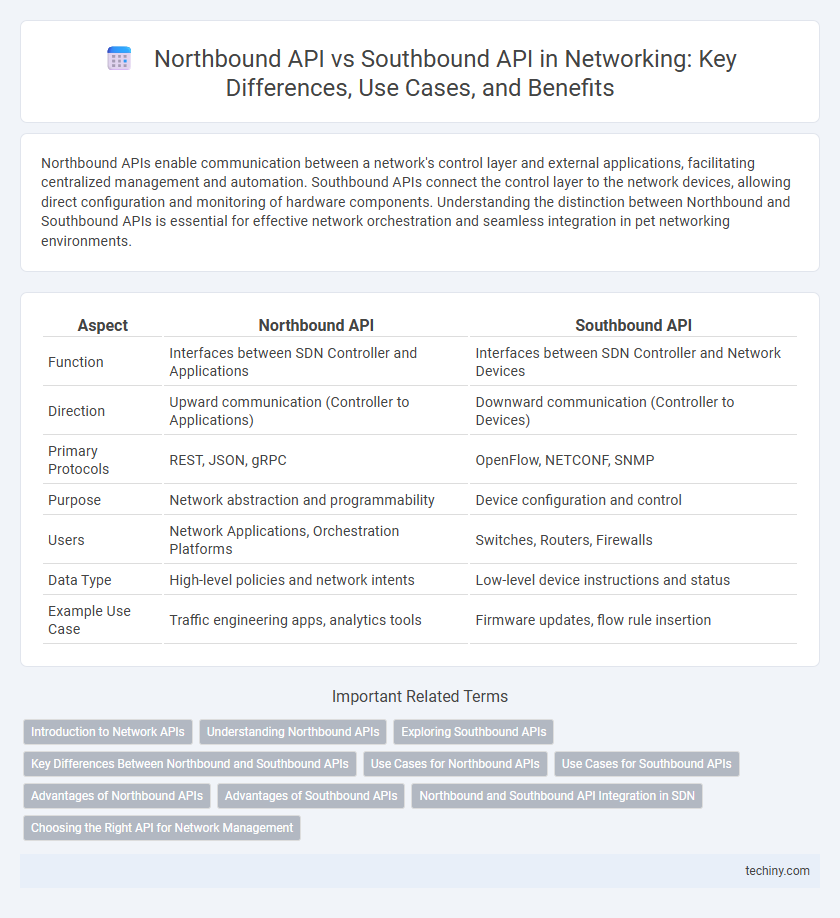Northbound APIs enable communication between a network's control layer and external applications, facilitating centralized management and automation. Southbound APIs connect the control layer to the network devices, allowing direct configuration and monitoring of hardware components. Understanding the distinction between Northbound and Southbound APIs is essential for effective network orchestration and seamless integration in pet networking environments.
Table of Comparison
| Aspect | Northbound API | Southbound API |
|---|---|---|
| Function | Interfaces between SDN Controller and Applications | Interfaces between SDN Controller and Network Devices |
| Direction | Upward communication (Controller to Applications) | Downward communication (Controller to Devices) |
| Primary Protocols | REST, JSON, gRPC | OpenFlow, NETCONF, SNMP |
| Purpose | Network abstraction and programmability | Device configuration and control |
| Users | Network Applications, Orchestration Platforms | Switches, Routers, Firewalls |
| Data Type | High-level policies and network intents | Low-level device instructions and status |
| Example Use Case | Traffic engineering apps, analytics tools | Firmware updates, flow rule insertion |
Introduction to Network APIs
Network APIs enable communication between different layers of a network architecture, facilitating automation and orchestration. Northbound APIs allow higher-level systems like management and orchestration platforms to interact with the network infrastructure, providing a simplified interface for network control and monitoring. Southbound APIs connect network devices such as routers and switches with the control layer, enabling configuration, data collection, and real-time network management.
Understanding Northbound APIs
Northbound APIs enable communication between the network controller and the applications or business logic layer, facilitating the integration of network services and automation tools. They provide a standardized interface for retrieving network data, monitoring performance, and managing policies, enhancing programmability and agility in software-defined networking (SDN). By abstracting underlying network infrastructure, Northbound APIs support dynamic and centralized control, improving network scalability and operational efficiency.
Exploring Southbound APIs
Southbound APIs enable communication between the network controller and the physical or virtual devices, facilitating device management, configuration, and monitoring. These APIs support protocols like OpenFlow, NETCONF, and SNMP to ensure seamless interaction with switches, routers, and firewalls in software-defined networking (SDN) environments. Effective use of Southbound APIs enhances network automation, reduces manual intervention, and improves operational efficiency.
Key Differences Between Northbound and Southbound APIs
Northbound APIs facilitate communication between the network control layer and applications, enabling programmability and automation by providing abstracted network information and control capabilities. Southbound APIs connect the network control layer to physical and virtual network devices, translating high-level commands into device-specific instructions for configuration and management. The key difference lies in their direction of communication and scope: northbound APIs support application-layer integration and service orchestration, while southbound APIs handle device-level interactions and protocol mediation.
Use Cases for Northbound APIs
Northbound APIs enable communication between the network management systems and applications, allowing operators to automate configurations and monitor network performance efficiently. They facilitate integration with orchestration platforms, enabling dynamic service provisioning and policy enforcement across multiple devices. Use cases include real-time analytics, network policy management, and seamless interaction with cloud-native environments to support scalable and programmable networks.
Use Cases for Southbound APIs
Southbound APIs primarily facilitate communication between network controllers and underlying infrastructure devices such as switches, routers, and firewalls, enabling dynamic configuration and real-time monitoring. Use cases include automating provisioning, enforcing policies, and collecting telemetry data from network elements to optimize performance and troubleshoot issues. These APIs support protocols like OpenFlow and NETCONF, which are essential for Software-Defined Networking (SDN) implementations.
Advantages of Northbound APIs
Northbound APIs facilitate seamless communication between the network control layer and business applications, enabling centralized network management and automation. They provide abstraction, allowing developers to integrate diverse network services without dealing with underlying complexities. Enhanced programmability and real-time data access through northbound APIs accelerate service orchestration and improve overall network agility.
Advantages of Southbound APIs
Southbound APIs facilitate direct communication between network controllers and physical or virtual devices, enabling efficient device management and configuration. Their advantages include real-time device monitoring, enhanced automation capabilities, and seamless integration with diverse hardware, which improve network agility and reduce operational costs. These APIs support programmability and scalability, essential for modern Software-Defined Networking (SDN) environments.
Northbound and Southbound API Integration in SDN
Northbound APIs in SDN enable communication between the SDN controller and the application layer, facilitating network programmability and policy enforcement through standardized interfaces like REST or NETCONF. Southbound APIs connect the SDN controller to the network devices, enabling control and management by using protocols such as OpenFlow, OVSDB, or NETCONF to configure and monitor switches and routers. Effective integration of Northbound and Southbound APIs is critical for achieving centralized control, dynamic network resource allocation, and seamless orchestration across diverse network infrastructures.
Choosing the Right API for Network Management
Choosing the right API for network management depends on whether control or data integration is prioritized; Northbound APIs enable communication from controllers to applications, offering abstraction and simplifying automation and orchestration, while Southbound APIs provide direct interaction with network devices for configuration and real-time data collection. Northbound APIs typically use RESTful services for ease of integration with higher-level business applications, whereas Southbound APIs rely on protocols like OpenFlow, NETCONF, or SNMP to manage physical and virtual network elements effectively. Selecting between Northbound and Southbound APIs directly impacts network scalability, programmability, and operational efficiency.
Northbound API vs Southbound API Infographic

 techiny.com
techiny.com